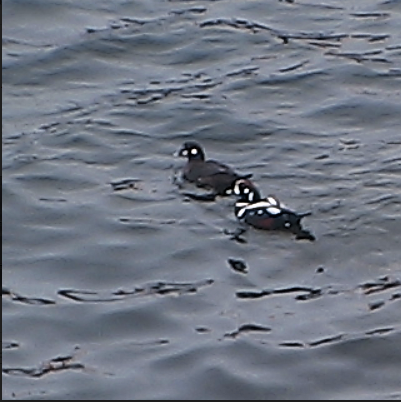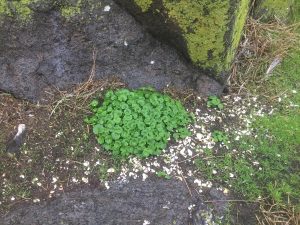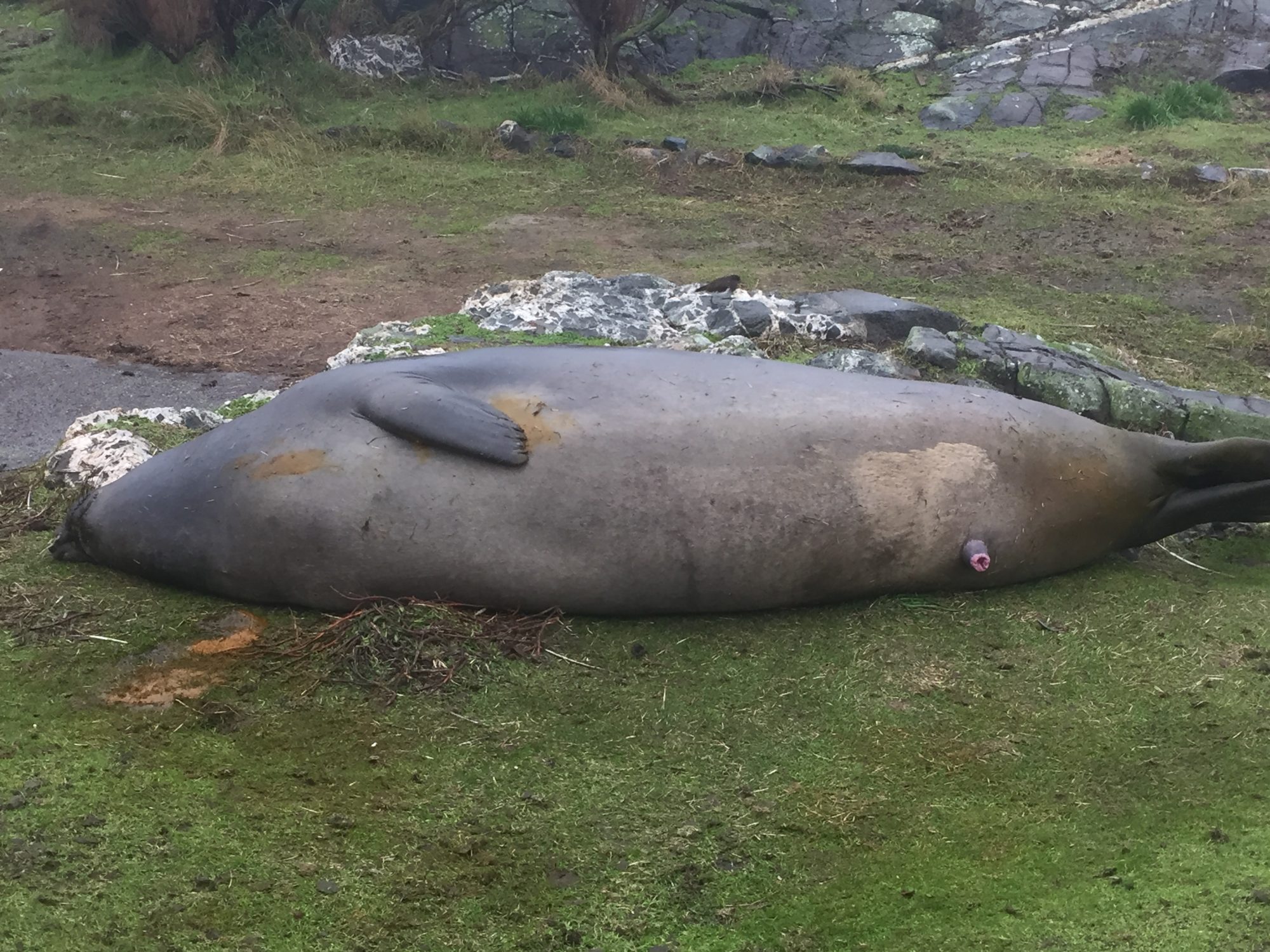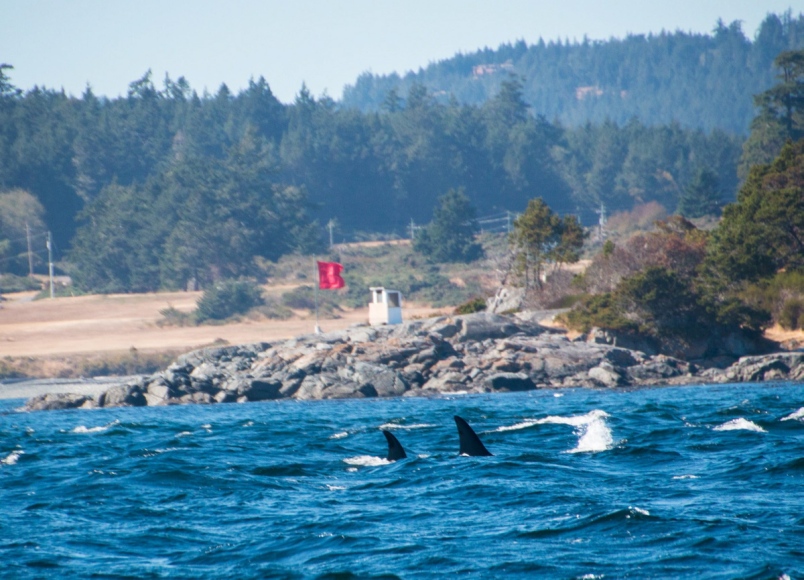This year is our 20th year in assisting the local birders with the Rocky Point Bird Observatory in doing a count at Race Rocks. Given the time of year this has to occur, it is often thwarted by bad weather, but in the past counts, some very interesting species and population numbers have shown up. See this index of past years Bird Counts. https://www.racerocks.ca/race-rocks-animals-plants/bird-observations-at-race-rocks-3/christmas-bird-counts-starting-in-1997/
Kim Beardmore same along to record the birds for the 2017 Christmas bird count. Here Kim on the left and the Ecoguardian Mikey Muscat check on one of the 5 male elephant seals.

Although we went to count birds, I found that the most impressive thing was that there were 5 large male elephant seals on the island and two juvenile females. When compared with other years this was quite unusual, and it could be interesting when the females come back in January to have pups. I predict there will be a lot of male aggression going on in mid-January.
- Black Turnstones
- Black Oystercatchers
- 3 species of Cormorant
- Pam Birley sent these Harlequin duck photos taken from camera 5
- Most of the Harlequins we observed were on the outer islands today.
These four species other than several gull species and bald eagles were part of the count which we will add below .
Other observations around the island:
- mud fields on North east corner
- rise to west of jetty
I took advantage of the few hours there to check on other aspects of the island from the ecological reserve warden point of view. Especially noticeable this year were the massive fields of mud over most parts of the island where the california sea lions hauled out over the past few months. I was concerned about the erosion and rock disturbance that this has caused. Most of the plants in many parts of the island have been obliterated. I did however find this one healthy patch of Romanzoffia tracyi behind the boathouse. Protected because of its location among the rocks. I checked some of the other known locations of this rare plant but didn’t see any.
One feature that was very evident with the lack of vegetation was the extensive beds of chiton shells which are evidence of black oystercatcher middens from last season.
Two immature or juvenile female elephant seals were on the island, one tagged ..green C887
- The comfort of a sidewalk?
- C887 juvenile female
- juvenile female
- Note muddy area below helipad
- Green tag C887
The five males:
- Male elephant seal 1
- elephant seal 2
- elephant seal 3
- elephant seal 4
- elephant seal 5
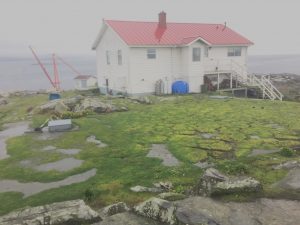 I have been watching the vegetation cover made up of the introduced species of Sedum or stonecrop which was on the top of the reservoir.. In my September photo the bed was quite dried and cracked. Now it has partially recovered.. This is one place the sealions seem to avoid.
I have been watching the vegetation cover made up of the introduced species of Sedum or stonecrop which was on the top of the reservoir.. In my September photo the bed was quite dried and cracked. Now it has partially recovered.. This is one place the sealions seem to avoid.
 Because Pearson College could not provide boat transportation this year, and because I was determined to continue the 20 year tradition of this valuable baseline collection of bird population data, we rented a boat from Pedder Bay marina for the trip to Race Rocks. A list of the birds observed by Kim Beardmore is attached here.
Because Pearson College could not provide boat transportation this year, and because I was determined to continue the 20 year tradition of this valuable baseline collection of bird population data, we rented a boat from Pedder Bay marina for the trip to Race Rocks. A list of the birds observed by Kim Beardmore is attached here.
Dec 28, 2017 9:05 AM – 11:37 AM
Protocol: Traveling
7.5 kilometer(s)
Comments: CBC, Race Rocks
16 species (+1 other taxa)Harlequin Duck 10 (North and west Race Rocks)
Surf Scoter 55 (outer pedder bay)
Red-breasted Merganser 18 (mostly outer Pedder bay)
Common Loon 2
Horned Grebe 1
Brandt’s Cormorant 14
Pelagic Cormorant 18
Double-crested Cormorant 10
Bald Eagle 4
Black Oystercatcher 42
Black Turnstone 59
Common Murre 1 ( in outer Pedder bay)
Pigeon Guillemot 10
Mew Gull 14
Iceland Gull (Thayer’s) 8
Glaucous-winged Gull 69
Western x Glaucous-winged Gull (hybrid) 2




